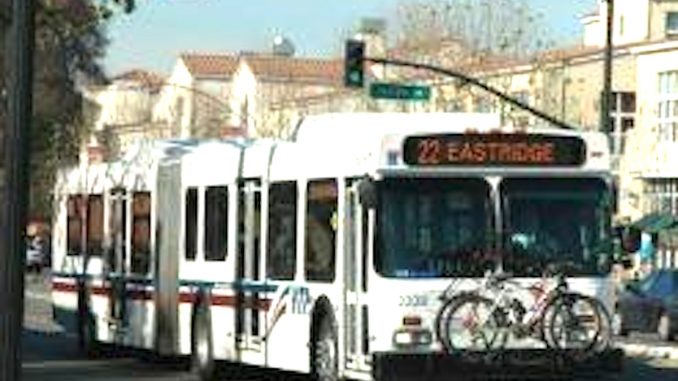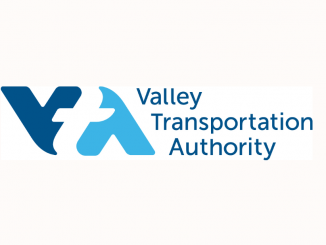
Editor’s note: This story has been clarified to explain how some homeless people get free passes to ride the bus.
BY ALLISON LEVITSKY
Daily Post Staff Writer
VTA is considering shutting down its only all-night bus — known as Hotel 22 to the 45 homeless residents who sleep on it — from 1 a.m. to 4 a.m.
The proposed change comes with a set of others that VTA is calling the 2019 Transit Service Plan, including route-merging and increased frequency in some areas, which will go before the board of directors in May.
Route 22 travels between the Palo Alto Transit Center on University Avenue and Eastridge Transit Center in East San Jose.
About 40 or 45 people who ride the bus between 1 a.m. and 4 a.m. use the bus as shelter, VTA spokeswoman Holly Perez said.
Another 120 — spread across three eastbound and three westbound trips — ride it for transportation.
Many homeless people ride the bus. Under what’s called the Uplift program, social service agencies issue free VTA passes to the homeless people who meet regularly with a case-management worker, a VTA spokeswoman said.
VTA is considering cutting the overnight service in order to save money on the wages for bus drivers, dispatchers and security guards at the two transit centers.
During the day, those costs are spread across all the routes, Perez said.
“We will be meeting in the coming weeks with a number of safety net and social service providers including HomeFirst, Catholic Charities and Destination Home,” Perez said. “We are certainly aware of the impact that this proposal could have on homeless riders and are working with community organizations that specialize in issues facing the homeless.”
VTA is also considering increasing the morning and evening frequency of the other El Camino route, 522, on weekdays and weekends, but that line makes fewer stops and doesn’t run between 11 p.m. and 6 a.m.
First driver helped the homeless
Chuck Jagoda, a 75-year-old Sunnyvale man who used to be homeless, said the Hotel 22 was established by a bus driver who would stop and pick up homeless people on his overnight shift to let them sleep on the bus.
He also let a couple of them stay at his home, Jagoda said.
“Regular people would get upset and it would interrupt their rides,” Jagoda said. “He almost lost his job. He was criticized for this.”
The proposal to cut the Hotel 22 would not be the first time VTA pushes homeless people off the bus, Jagoda said.
In the past, homeless riders could sleep in their seats all night. Then the bus started stopping for a half-over layover at Eastridge and the driver would walk down the aisle waking people up to get them off the bus, so they couldn’t sleep through the night.
“This was instituted on purpose to make it less welcoming for homeless people,” Jagoda said. “The policy toward homeless people has been the ‘stray cat theory’… These are stray cats. If you put milk out for them, they keep coming back.”
Jagoda thinks VTA should provide more services for the homeless, not fewer. “Most of the homeless people I know are from here. They went to Cubberley High School,” Jagoda said.
“It’s a myth that people come here for the wonderful benefits.”
Jagoda said elected officials and bureaucrats aren’t incentivized to advocate for the homeless.
“We don’t have any advocates,” Jagoda said. “Keeping the homeless people fed or alive is not high on their list, according to my observations of their behavior.”
People choose to sleep on the bus for several reasons, Jagoda said. There aren’t enough shelter beds, and for some, the bus feels safer than sleeping outside or in a shelter.
The alternatives are few. Public space in the Palo Alto area has become more restricted to people sleeping outside, Jagoda said, citing the crackdown on campers at Cubberley Community Center and the “parkification” of places such as San Francisquito Creek.
Jagoda knows some people who would get off the Hotel 22 and spend the rest of the night someplace that was open all night, such as Happy Donuts in south Palo Alto or the Safeway at San Antonio Village in Mountain View.
Hearing next week
VTA is planning a series of meetings to get feedback from the public on the proposed changes. One such meeting is planned for 6 p.m. Wednesday (Feb. 6) at the Mountain View Senior Center.




Before they shut down the 22, VTA should figure out where these people are going to go. Seems this decision will only make things worse for these individuals.
The homeless shouldn’t be able to take over a bus route! Why are we allowing our public transit buses to become rolling homeless shelters. Yes, by all means, cancel the route.
They aren’t the only ones who use that route. I used to depend on it when I was working late in Palo Alto, and living in San Jose. If the route exists and is servicing people (like me) who depend on it to avoid homelessness, those resources are already allocated. Why not let it serve a dual function and provide people a warm, safe place to sleep?
Your desire to punish the homeless for having the temerity to exist will deprive the struggling-but-not-yet-homeless of a vital resource, and create more homeless people.
But hey, at least you won’t have to see them on the bus, right?
Eff this. Make Facebook pay for it since they wanna hoard so much damn money. This is discusting. We’re the wealthiest state in the country and we treat homeless people this way?! SHAME ON US.
@Greg Y, I mean YOU. You are an awful human being. I hope Karma gets you.